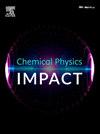Unraveling the genetic landscape of high-risk retinoblastoma through transcriptome profiling
IF 3.8
Q2 CHEMISTRY, PHYSICAL
引用次数: 0
Abstract
Retinoblastoma (RB), a rare and aggressive pediatric cancer, presents severe challenges in treatment due to its genetic complexity. It's crucial to develop tailored therapies for high-risk RB cases. We conducted transcriptome profiling to investigate gene expression patterns and identify genetic factors associated with high-risk RB. Molecular modeling-based drug discovery was subsequently used to identify novel compounds targeting high-risk retinoblastoma genetic factors. In our research, we identified dysregulated genes, prioritizing polo-like kinase 1 (PLK1) for drug targeting. Further investigation of the PLK1 gene revealed its relationships with microRNAs (miRNAs), transcription factors (TFs), and protein kinases, implying its role in RB. Differentially expressed PLK1 correlates with dysregulated cell cycle, suggesting its involvement in RB progression. Molecular docking, simulations, and thermodynamic free energy calculations assessed the potential of small drug-like molecules, leading to the identification of two potent PLK1 inhibitors, compounds 1950 and 2760. These inhibitors hold promise for inhibiting the growth of RB cells. Our findings underscore PLK1 as a promising therapeutic target, highlighting computational approaches' efficacy in RB research.
通过转录组分析揭示高风险视网膜母细胞瘤的遗传景观
视网膜母细胞瘤(RB)是一种罕见的侵袭性儿科癌症,由于其遗传复杂性,在治疗中提出了严峻的挑战。针对高危RB病例开发量身定制的治疗方法至关重要。我们进行了转录组分析来研究基因表达模式,并确定与高危RB相关的遗传因素。基于分子模型的药物发现随后被用于识别针对高风险视网膜母细胞瘤遗传因素的新化合物。在我们的研究中,我们发现了失调的基因,优先考虑polo样激酶1 (PLK1)作为药物靶向。PLK1基因的进一步研究揭示了其与microrna (miRNAs)、转录因子(tf)和蛋白激酶的关系,暗示其在RB中的作用。差异表达的PLK1与细胞周期失调相关,提示其参与RB进展。分子对接、模拟和热力学自由能计算评估了小药物样分子的潜力,从而确定了两种有效的PLK1抑制剂,化合物1950和2760。这些抑制剂有望抑制RB细胞的生长。我们的研究结果强调了PLK1作为一个有希望的治疗靶点,突出了计算方法在RB研究中的有效性。
本文章由计算机程序翻译,如有差异,请以英文原文为准。
求助全文
约1分钟内获得全文
求助全文
来源期刊

Chemical Physics Impact
Materials Science-Materials Science (miscellaneous)
CiteScore
2.60
自引率
0.00%
发文量
65
审稿时长
46 days
 求助内容:
求助内容: 应助结果提醒方式:
应助结果提醒方式:


